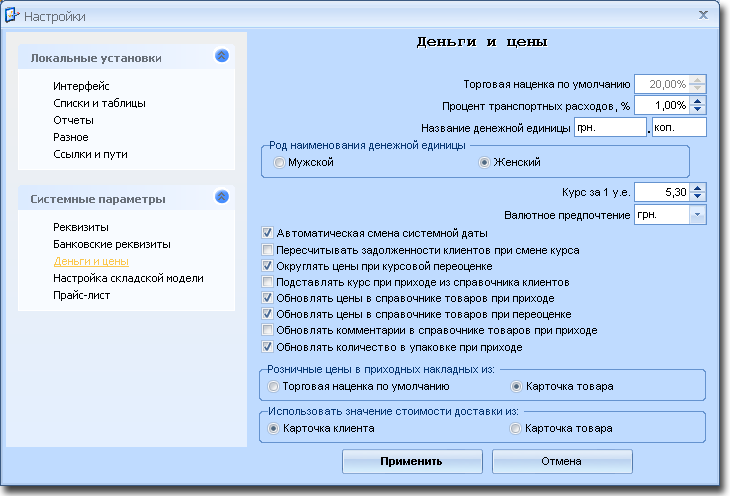
Settings - section "Money and prices"

| • | Skip the menu item "Empty database" - a test database that comes in the distribution can be cleaned with a menu button "Clear base, but after clearing the bases for safety button becomes available. To repeat the cleaning, you must reinstall this box. |
| • | Trading margin by default - the value of margin to be added to the purchase price and, thus, forming the retail price. Example of using the principle of auto-interference "when the system substitutes the value and uses it in calculations, but allows the user to change at any time. The principle of "automatic intervention" is an auxiliary, prompts the user to the most typical activities and settings. |
| • | Name of monetary unit - the national currency unit used in the TCU. |
| • | The genus name of the monetary unit - male or female. Used for the correct formation of the endings in the reports. |
| • | Course for 1 "cu" - TCU ticket office at the two-track, ie in national currency and in U.S. dollars As the "cu" You can use the U.S. dollar, Euro or any other. In fact, you determine its value rate for 1 USD When changing the course and clicking "Apply" are acts of foreign exchange revaluation. Reassessment will occur in accordance with the "re-evaluate when you change course - details read on. |
| • | Currency preference - support the currency by changing course. This currency at foreign exchange revaluation remains fixed, while the opposite currency varies according to the course. For example, a product with price 530 USD at the rate of 5.3 USD per Euro has a dollar price = 100. If the currency preference when you change the course will be defined as torque, the new price of the goods will be UAH 530 (no change), and ue - Changes in accordance with the course. If the currency preference when you change the course will be defined as cu, then the new price of the goods in UAH changes (exchange rate), and ue will remain the same - $ 100 |
| • | Automatic change of system date - if you select the operating date in the TCU is tied to the computer's system date and, accordingly, changed every day. When you clear the working date TCU changed manually by a user with the right to change the date. |
| • | Recalculate the debt clients in changing their policy - when you select when you change the course of 1 cu will be converted clients' debts based on the principle outlined above. For example, a customer at a rate of 1 cu = 5,3 UAH, and the variable "re-evaluate when changing course in the UAH" owed 530 USD, accounting for $ 100 When changing the course from 5.30 to 5.10 for 1 cu debt client will change: $ 100 * 5.10 = 510 UAH. If the option is "re-evaluate the change in course in U.S. dollars" then a fixed sum will be 530 USD and payable in U.S. dollars be 530 / 5.10 = 103.92 cu |
| • | Rounding the prices for exchange rate revaluation - as was shown above, the exchange rate revaluation in the fractional part of the price of a product may contain a lot of numbers. You can continue to work with such prices, but it is desirable to reduce the number of digits to the number set in the System Preferences under "interface" - "characters after the comma." In this case the price of round. Rounding would change the other currencies (exchange rate). Thus, the commodity with the price $ 100 After rounding the reverse may take a value of 99.99 cu |
| • | Substitute a course on arrival from the directory of clients - the course of 1 cu can be taken from the customer's card (individual course). Only when you select is activated by the "Currency-client" in the customer card. |
| • | Update the prices of goods on arrival reference - the reference price of the goods will correspond to the price of goods at his last parish. Advisable to leave it on. |
| • | Update the prices of goods in the directory of the revaluation - the reference price of the goods will correspond to the price of goods at its last revaluation. Advisable to leave it on. |
| • | Update the comments in reference goods on arrival - in the card product will be recorded comments from a credit note. |
| • | Update of the package on arrival - the item card number will be updated in the package (according to the latest Invoice). |
| • | Retail prices in the receipt of invoices: - defining a source of reference data. |
| • | Use the value of the cost of delivery of: - defining a data source for the calculations. |
See also Help